– Could you tell us about your professional career and how you came to this position? What skills help you effectively carry out your responsibilities? How do you understand the essence of your role?
– I have been serving in this position for three years. I was born and raised here myself. Before being appointed as the khokim’s assistant, I worked as a farmer for 10 years, and then spent 5 years in entrepreneurship. The experience and skills I gained during those years help me greatly today because I’m well acquainted with the problems and needs of the residents in our mahalla. Our main responsibilities include conducting in-depth assessments of each household in the mahalla, ensuring employment for the local population, training unemployed citizens in new professions, supporting entrepreneurship in the community, and facilitating access to loans and subsidies to support local business initiatives.
– Could you describe in more detail the location of your mahalla, the available infrastructure, and employment opportunities?
– Our mahalla has a total of 1,155 households, home to 6,450 residents. The "Kuyosh" mahalla is located 8 kilometers from the center of Syrdarya district. There are two rural medical centers, three general education schools, one state preschool, two private kindergartens, and a private medical facility with 50 beds. I can confidently say that the existing infrastructure fully meets the needs of our residents. Most of the population is engaged in farming on their household plots.
Four kilometers from the “Kuyosh” mahalla, there is a glass factory established in cooperation with Germany. This enterprise currently provides stable employment to about 230 citizens.
– According to survey data, what were the priority objectives and main drivers of development in your mahalla?
– I began working in January 2022. The first step was to conduct a comprehensive survey of every household in the mahalla — assessing the socio-economic status of the residents, their employment situation, number of unemployed individuals, and their needs and aspirations. Based on the findings, a development plan was formulated with specific goals to improve the household economy. Given the regional context, the key drivers of development were identified as greenhouse farming (primarily tomatoes, cucumbers, and bell peppers), plant nurseries, and lemon cultivation. When we began our efforts, around 300 households had greenhouses on their plots; by the end of 2024, that number had risen to 970.
A population census conducted in January 2022 revealed 380 unemployed individuals in the mahalla. Today, only 8 remain on that list and even they are not idle. They are engaged in self-employed farming on their land. Through a leasing program, they have been provided with motor cultivators and mini-tractors.
– It has been noted that your mahalla achieved notable results in vegetable cultivation under the "One Mahalla – One Product" initiative. Could you tell us more about the efforts in this area?
– We began working in this direction back in 2022, and the progress since then has been significant. At that time, almost no export-oriented crops were being grown in the region — produce was sold only at local markets. We reached agreements with the dehkans (farmers) in our mahalla, and under the "One Mahalla – One Product" initiative, we imported high-yield seeds from Israel and the Netherlands. The goal was to provide employment for temporarily unemployed citizens, make efficient use of household land, develop livestock and poultry farming, improve family incomes, and ultimately reduce poverty.
We reached an agreement with all the farmers to grow the same types of produce: tomatoes, cucumbers, and bell peppers, and to export them in a centralized manner. That’s how it all began. As part of the preparatory work, training courses were organized for households on how to effectively use household plots, which proved especially useful for the self-employed dehqans of the mahalla. During these courses, participants received detailed explanations on topics such as household cooperation, centralized sales of produce, efficient use of plots, subsidies, banking services, and procedures for obtaining preferential loans.
In addition, an enterprise called "Tomorka Xizmati" was established in the "Kuyosh" mahalla to provide services to local dehqans. For instance, dehqans can rent mini tillers, mini tractors, and various greenhouse equipment there. This also creates convenience for low-income citizens who do not own agricultural tools, they can defer rental payments until after the harvest.
– In how many households of the mahalla has this principle-based approach been implemented? On average, how much produce does one greenhouse yield? How much was exported last year?
– In the Quyosh mahalla alone, a greenhouse averaging 8 acres brings in about 200 million sums in annual income. In 2023, vegetables worth over 35 billion sums were exported from our mahalla to two regions of Russia. According to our estimates, this figure exceeded 45 billion sums in 2024. For example, Tursunov, a resident of the Kuyosh mahalla in the Syrdarya district, is successfully running a greenhouse business on his household plot.
It’s worth noting that the vegetables grown in the mahalla are packaged and processed right here. These services were organized in one of the local households, providing daily employment for local women.
– It turns out that lemon cultivation has also begun in the mahalla. Can you tell us more about this?
– Yes, that’s correct. Intensive efforts are underway to develop lemon growing. For instance, last year we sold over 2 tons of lemons in one season from a lemon orchard of just 200 square meters. At a price of 45,000 sums per kilo, up to 200 kg of lemons can be harvested from a single tree annually, significantly improving the household’s finances. I strongly promote lemon cultivation in the mahalla because growing lemons in a greenhouse is far more profitable than growing tomatoes, cucumbers, or other vegetables. I studied the techniques of lemon cultivation by visiting Kokand and the Dangara district.
This spring, we plan to bring lemon saplings from Fergana for 300 households, start growing them in greenhouses, and provide full training to dehqans on lemon cultivation. Farmers from the Dangara district will also assist us. We have all the necessary resources to implement this.
For example, we helped Erkin Nishonov obtain a loan, and he built a greenhouse. Mahalla representatives supported him at every stage of the construction. We’ve set up a system to grow saplings on a pre-order basis, which earns us over 100 million sums. Once the seedlings are delivered, we’ll plant tomatoes and cucumbers in the soil, and our annual income will exceed 200 million sums. Just last year, 25 mahalla residents received loans for entrepreneurship. The total number of self-employed citizens in the mahalla has reached 1,185.
– In your opinion, what are the main causes and contributing factors of poverty? What else needs to be done to further reduce poverty in the region?
– The causes of poverty may vary depending on the mahalla’s location. However, there are some common patterns. Based on my experience, I can say that many citizens have a deeply rooted dependency mindset - some mistakenly believe that others should solve their problems for them. Moreover, laziness is also quite common. As a result, existing opportunities are underutilized. For instance, some families still do not use their land effectively. We are working systematically to prevent such situations, based on a well-designed action plan.
As for the second part of the question, additional measures are necessary to completely eradicate poverty. In particular, we must continue allocating household plots to citizens who are ready to work. I also believe that cooperation with large factories and industrial enterprises should be strengthened, offering jobs to the local population, providing them with insights into entrepreneurship, and delivering comprehensive support.
– What efforts are being made in the mahalla to support citizens working abroad and encourage them to return home?
– A separate registry has been compiled in the mahalla to assist labor migrants. Currently, 18 citizens from our mahalla are temporarily working abroad. We have contacted each of them and assessed their situations. A special plan has been developed to support the return of citizens who have worked abroad and are not earning sufficient income, with the goal of providing them employment opportunities here at home. It was explained in detail that upon returning, they would receive the necessary financial and other support to start a business or engage in entrepreneurial activity.
– Based on your practical experience as a khokim’s assistant, what suggestions can you offer to further improve the performance of hokim assistants in Uzbekistan? What kind of support do you need?
– All necessary conditions have been created for khokim assistants to work effectively, and we make full use of them. However, I believe that the volume of financial resources allocated for the economic development of mahallas should be further increased, taking into account the specific potential of each region. It would also be advisable to reduce the influence of sector leaders in the districts. Further liberalization of hokim assistants’ activities would also help increase the effectiveness of our work.
– At the meeting chaired by the President on February 3 of this year, a task was set to "revitalize and give new momentum" to the work of khokim assistants. Based on this, what initiatives are planned in your mahalla?
– Indeed, at that meeting, new tasks were assigned to the mahalla’s “Group of Seven,” including khokim assistants. From now on, they will also be responsible for organizing crop planting on household plots. Local bankers have also joined the “Group of Seven” (one banker for every four mahallas), which will further support our work. Based on my experience, there are many untapped opportunities in rural areas - you just have to look for them. As the saying goes, “He who seeks will find the opportunity.”
– How has the attitude of mahalla residents toward the ongoing reforms changed? What goals have you set for yourself now?
– Speaking of future plans, in order to further develop the mahalla’s economy, we have proposed reserving 30 hectares of land from a neighboring farm and distributing it to our citizens through auctions, 0.15 hectares per household. The plan is to prioritize land distribution to low-income families registered in the “Social Register” and the “Women’s Notebook.” As a result, we aim to increase the mahalla’s export volume to over 60 billion sums by the end of 2025. There is demand for our produce, a purchase proposal has already come from Russia’s Novosibirsk region.
In conclusion, I would like to say that all of our achievements are the result of hard work. If we continue to act with dedication for the good of our country, we will undoubtedly achieve great success!
Jamoliddin Turdimov, CERR
"Economic Review" Journal №2/2025

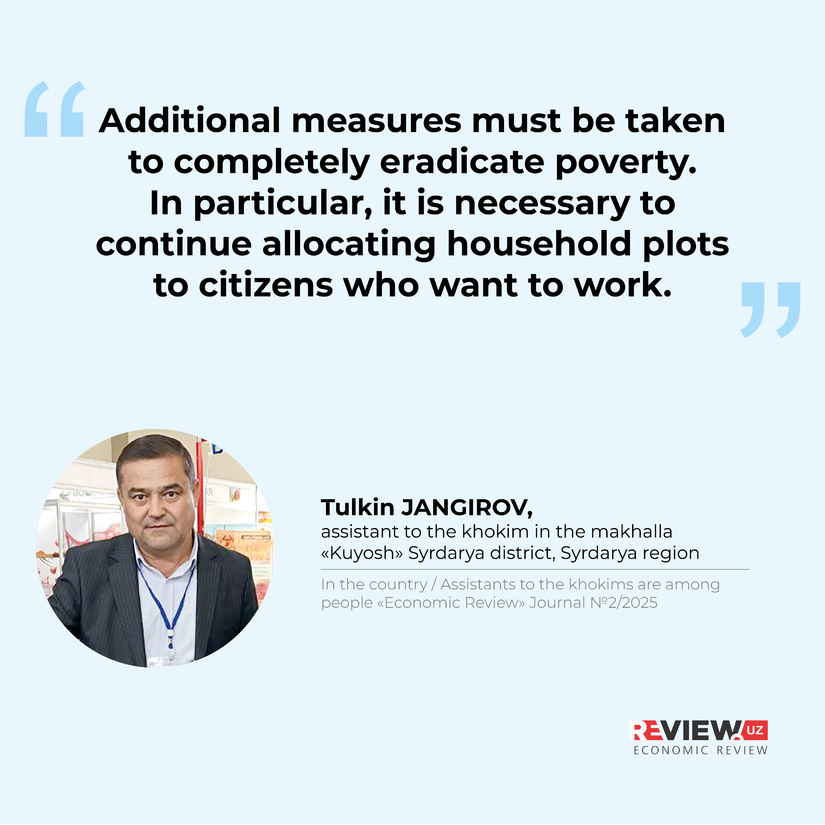


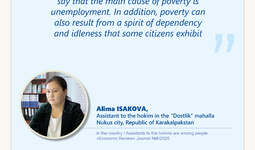
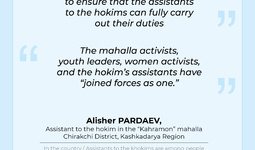
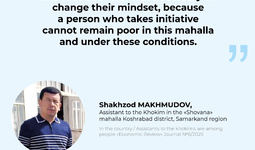
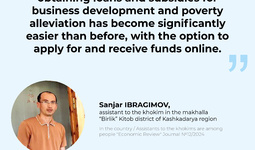













leave a comment